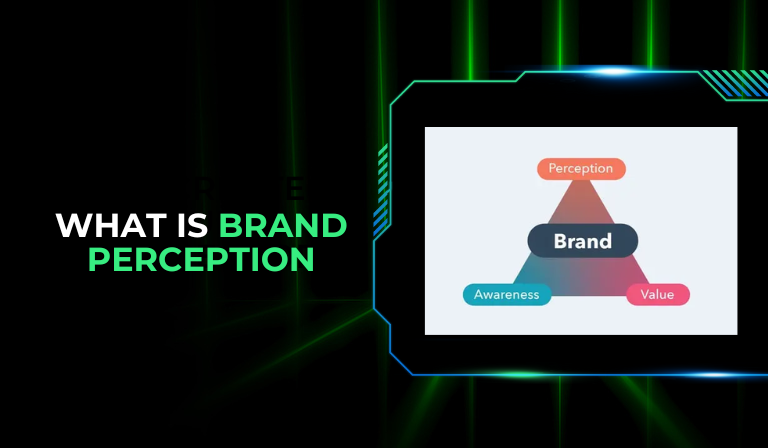In the fiercely competitive world of business, brand perception is a pivotal element. It is the way consumers see and feel about a brand. Understanding this concept and its significance can be a game-changer for any organization. In this blog, we will delve into what brand perception is and how to measure it effectively.
What Is Brand Perception?
Brand perception is how customers, both current and potential, view your brand. It encompasses their thoughts, feelings, and opinions about your products, services, and the overall image your brand projects.
This perception can be influenced by a variety of factors, including your marketing efforts, customer experiences, and the quality of your products or services.
Key Elements of Brand Perception
To grasp the concept fully, let’s break it down into its key elements:
1. Trust
Trust is the foundation of brand perception. When consumers trust your brand, they are more likely to choose your products or services over alternatives.
2. Quality
Perceived quality matters. Customers associate a positive brand perception with high-quality products or services.
3. Consistency
A brand’s consistency in delivering what it promises plays a pivotal role in shaping perception. Consistency builds trust.
4. Emotional Connection
Consumers often form emotional bonds with brands. A brand that evokes positive emotions tends to have a better perception.
5. Differentiation
How distinct is your brand from competitors? Being unique can make your brand stand out and improve perception.
Why Does Brand Perception Matter?
Brand perception holds immense importance for several reasons:
1. Customer Loyalty
A positive brand perception fosters customer loyalty. When customers have a favorable opinion of your brand, they are more likely to stay loyal over time.
2. Competitive Edge
A strong brand perception gives you a competitive edge. It can differentiate your brand from others in the market.
3. Pricing Flexibility
When customers perceive your brand as high-quality and trustworthy, you have the flexibility to set higher prices.
4. Word of Mouth
A positive brand perception can lead to customers becoming brand advocates, promoting your products or services through word of mouth.
5. Crisis Management
A good brand perception acts as a buffer during crises. Loyal customers are more forgiving when they have a positive perception of your brand.
How to Measure Brand Perception
Now that we understand the significance of brand perception, let’s explore how to measure it:
1. Surveys and Questionnaires
Conducting surveys and questionnaires can help gather data on how consumers perceive your brand. Ask questions about trust, quality, and their emotional connection with your brand.
2. Social Media Listening
Monitor social media platforms to gauge what people are saying about your brand. Tools and software can assist in tracking brand mentions and sentiment analysis.
3. Net Promoter Score (NPS)
The Net Promoter Score is a simple but effective way to measure brand perception. It asks customers how likely they are to recommend your brand to others.
4. Customer Reviews
Analyze customer reviews and feedback, whether on your website, e-commerce platforms, or review sites. These can provide valuable insights into perception.
5. Competitor Analysis
Comparing your brand perception with that of competitors can offer a clear picture of your standing in the market.
Factors Shaping Brand Perception
Brand perception isn’t static; it’s influenced by various factors. Let’s explore some of these key influencers:
1. Marketing and Advertising
Your marketing efforts, including branding, advertising, and messaging, play a significant role in shaping perception. Consistent, positive messaging can enhance brand perception.
2. Customer Service
Customer interactions, the speed of problem resolution, and overall service quality can significantly impact how customers perceive your brand.
3. Product or Service Quality
The actual quality of your products or services is a fundamental factor. Meeting or exceeding customer expectations is crucial for a positive perception.
4. Online Presence
In the digital age, your online presence, including your website and social media profiles, contributes to how consumers perceive your brand.
5. Brand Values
Consumers are increasingly conscious of a brand’s values. Brands that align with their values tend to have a better perception.
Brand Perception Examples
Coca-Cola vs. Pepsi
Brand Perception: Coca-Cola is perceived as a timeless, classic brand with a focus on bringing people together, often linked with happiness and sharing. Pepsi, on the other hand, positions itself as the choice for a younger, more rebellious generation with edgier marketing.
Impact: This perception is reinforced by Coca-Cola’s traditional holiday ads and nostalgic branding, while Pepsi’s campaigns often feature pop culture icons and a vibrant, modern vibe. Their brand perceptions create distinct consumer loyalty, with many customers choosing one over the other based purely on the brand image.
Apple
Brand Perception: Apple is widely seen as a high-end, innovative, and user-friendly brand that emphasizes design, privacy, and premium quality. It has cultivated a perception of exclusivity and status, often associated with luxury and technological sophistication.
Impact: This perception allows Apple to command premium pricing and fosters strong brand loyalty, with customers lining up for new product releases. Apple’s focus on clean design, privacy, and ease of use has helped the brand develop a near-fanatic customer base who often prefer Apple products over competitors.
Patagonia
Brand Perception: Patagonia is perceived as an environmentally responsible brand that prioritizes sustainability and ethical production. It resonates deeply with consumers who value environmental stewardship and social responsibility.
Impact: Patagonia’s commitment to environmental causes has attracted a dedicated customer base that chooses the brand not just for quality outdoor gear but to support its values. Initiatives like the “Worn Wear” program (which encourages reusing and recycling clothing) reinforce this perception, helping Patagonia build both brand loyalty and respect in a competitive industry.
Tesla
Brand Perception: Tesla is perceived as an innovative, futuristic brand leading the charge toward sustainable transportation. It’s also seen as cutting-edge, with a commitment to pushing boundaries in technology, particularly in the electric vehicle (EV) sector.
Impact: Tesla’s brand perception draws in environmentally conscious consumers and tech enthusiasts alike. By positioning itself as both a luxury and eco-friendly brand, Tesla has successfully attracted a market willing to pay more for perceived sustainability and innovation, which in turn reinforces Tesla’s positioning as a leader in the EV space.
Zoom
Brand Perception: At the start of the pandemic, Zoom was seen as a convenient, easy-to-use platform that kept people connected, which quickly elevated it to the go-to video conferencing software. However, with extended use, “Zoom fatigue” set in, shifting the brand’s perception slightly toward a tool that contributes to digital fatigue.
Impact: Zoom adapted its brand to account for these shifts by introducing new features like blurred backgrounds, more interactive tools, and privacy enhancements. The company also shifted messaging to focus on its role as a necessary tool for remote work and social connection, balancing utility with an understanding of user fatigue.
The Strategic Value of Brand Perception
Brand perception isn’t just a passive reflection of consumer thoughts—it’s a powerful tool that brands can strategically shape and monitor to drive growth. When companies understand how they’re perceived, they can make strategic decisions that align more closely with consumer desires. Here are some ways to leverage brand perception:
Shape Brand Identity: Use perception data to adjust brand identity and align messaging with consumer values and expectations.
Refine Marketing Campaigns: Insights from brand perception can inform campaigns that resonate more deeply, using language and visuals that align with consumers’ emotions and values.
Adapt to Shifts in Perception: When brand perception shifts due to external factors (like “Zoom fatigue”), agile brands can adjust messaging to reflect empathy and stay relevant.
Maintain Consumer Loyalty: Positive brand perception leads to stronger brand equity, turning customers into brand advocates who return repeatedly and promote the brand within their social circles.
FAQs
1. What is the difference between brand perception and brand identity?
Brand identity is how a brand portrays itself to the world, including its logo, messaging, values, and voice. It’s the set of characteristics and promises a brand controls and wants to be associated with.
Brand perception, on the other hand, is how consumers actually view and feel about the brand based on their experiences and interactions.
While brand identity is in the brand’s control, brand perception is shaped by consumers’ responses and can differ significantly from a brand’s intended image.
2. Why is brand perception important for businesses?
Brand perception directly impacts a company’s ability to attract and retain customers. Positive brand perception leads to greater brand loyalty, positive word-of-mouth, and increased sales, while negative perception can harm the brand’s reputation and reduce customer retention.
Strong brand perception also drives brand equity, making it easier to introduce new products, adjust prices, and expand market reach successfully.
3. How can I improve my brand’s perception?
Improving brand perception involves creating a consistent, high-quality customer experience, aligning your messaging with consumer values, and delivering on brand promises. Key steps include:
- Conducting regular surveys to understand customer sentiment.
- Enhancing customer service for better experiences.
- Engaging authentically on social media and addressing negative feedback.
- Promoting transparency in business practices, such as sustainability efforts.
- Refining marketing campaigns to better reflect consumer needs and values.
4. How does social listening help in measuring brand perception?
Social listening tools help brands monitor conversations and mentions across social media and online forums. By analyzing these conversations, brands gain insights into how they are viewed, what consumers say about their experiences, and how they compare to competitors.
This real-time feedback allows companies to address concerns, leverage positive feedback, and adapt to consumer expectations as they evolve.
5. What is brand equity, and how is it related to brand perception?
Brand equity refers to the value a brand holds in the market, driven by customer loyalty, recognition, and perception. Positive brand perception creates strong brand equity by fostering trust and preference for the brand.
This loyalty makes customers willing to pay a premium, try new offerings, and recommend the brand to others. Conversely, negative brand perception can reduce brand equity, making it difficult for a company to maintain competitive advantage and customer retention.
6. Can brand perception change over time?
Yes, brand perception is dynamic and can change due to various factors, such as shifts in consumer expectations, competitor actions, or internal brand changes.
External events like a product recall, a PR crisis, or a viral campaign can also impact perception. Brands that monitor perception and stay responsive to feedback are better positioned to manage changes and maintain positive consumer relationships.
Conclusion
Brand perception is a critical factor in the success of any business. Understanding what it is, why it matters, and how to measure it is essential for building a positive brand image. By focusing on trust, quality, consistency, emotional connection, and differentiation, brands can foster a favorable perception.
Measuring brand perception through surveys, social media listening, NPS, customer reviews, and competitor analysis provides valuable insights. Factors like marketing, customer service, product quality, online presence, and brand values all play a role in shaping how consumers perceive your brand.
In a dynamic and competitive marketplace, adapting and actively working on brand perception can be the key to building customer loyalty and maintaining a competitive edge.
An avid blogger, dedicated to boosting brand presence, optimizing SEO, and delivering results in digital marketing. With a keen eye for trends, he’s committed to driving engagement and ROI in the ever-evolving digital landscape. Let’s connect and explore digital possibilities together.











